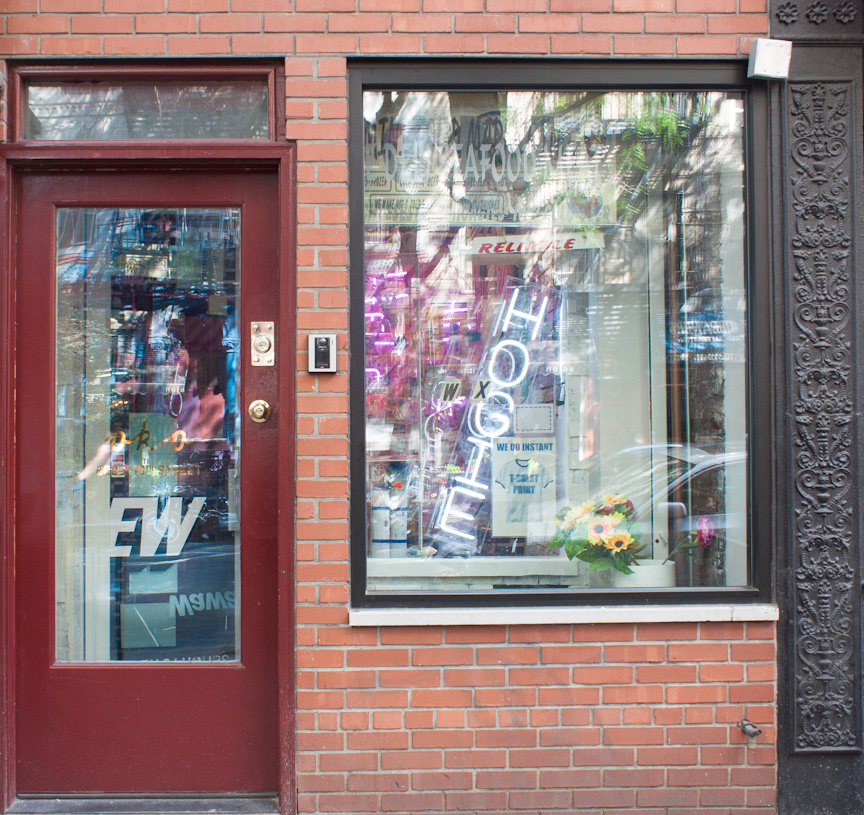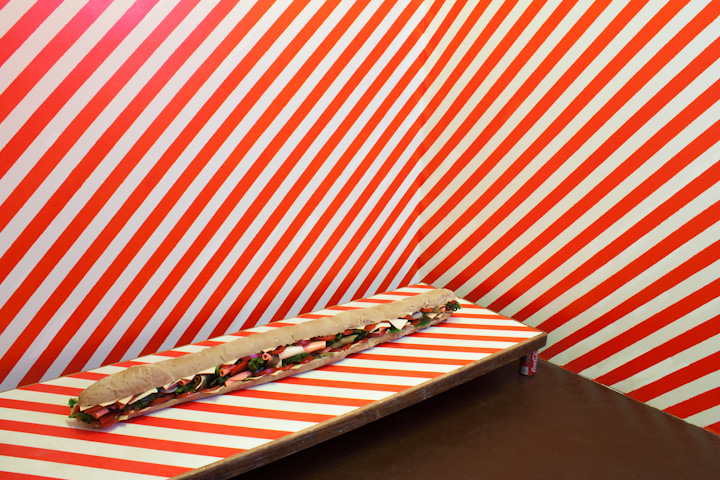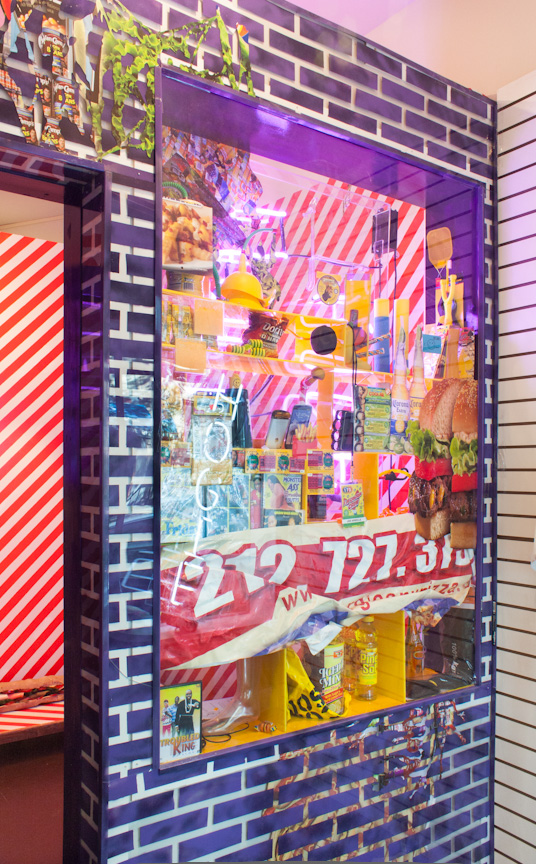
- Source: INTERVIEW
- Author: Allyson Shiffman
- Date: AUGUST 13, 2013
- Format: DIGITAL
Art, Power, and The Sandwich




There is no relationship more tumultuous than that between a New Yorker and her deli. You love them for their convenient location, yet you hate them for their arbitrary pricing. They carry your preferred brand of potato chip but not your favorite face wash. They are there for you at all hours of the day, yet they probably never bothered to learn your name. Artists Alex Da Corte and Borna Sammak unravel the origin of our relationship with the deli and its most alluring gift, the hoagie, with their installation “As Is Wet Hoagie,” on view now at East Village gallery Oko.
“The deli becomes your friend, but it’s the friend that doesn’t give a fuck about you,” explains Sammak. Both Sammak and Da Corte hail from Philly, where the hoagie reigns supreme. In addition to a hometown, the two artists share a dry sense of humor and a penchant for the grotesque. While they have maintained vague plans to collaborate artistically for years, it wasn’t until microscopic gallery Oko opened its doors to them that they decided to explore the imagery, signage, and evolution of this modern institution. In addition to replicating the “deli experience,” the installation alludes to the pursuit of our primal desires, manifested in the monstrous rubber sandwich at the core of the exhibit. The result is at once witty and truthful; truthful enough to trick many a passerby into popping in to ask for a cold-cut sandwich or to have a t-shirt printed. We caught up with Da Corte and Sammak to chat about the details of their collaboration, delis, and The Simpsons.
ALLYSON SHIFFMAN: How do you two know each other?
ALEX DA CORTE: We’re old friends.
BORNA SAMMAK: We’re old friends now?
DA CORTE: We’re the oldest friends. We’re both from Philly. Borna lives here, I live in Philly still.
SAMMAK: We text a lot, though.
SHIFFMAN: How did you go about conceptualizing this installation?
DA CORTE: We’ve been talking about a show abstractly for a really long time. We’d see something and send each other photos, always speaking to “our show,” but not having a destination for that show. I think the concept grows gradually then you lock down what the format will be. When we found this space, we started thinking about the East Village, Claes Oldenburg’s store, and how we’re engaged with objects in different stores of the same caliber like thrift stores, bodegas, and delis. It became a compression of all those pieces.
SHIFFMAN: I presume having the hoagie at the center has something to do with the fact that you’re both from Philly?
SAMMAK: Yeah. [both laugh]
SHIFFMAN: I learned a lot about hoagies earlier today on the hoagie Wikipedia page. Even though it’s really just a sandwich, the history and the vernacular turn it into a piece of American iconography.
DA CORTE: When we were thinking about the reference for the image of the long hoagie, we were thinking about that episode of The Simpsons…
SHIFFMAN: Where Homer is eating the giant sandwich!
DA CORTE: Yes. And he can’t finish the sandwich, but he keeps it around and it turns gray and he gets really sick. There’s something about obtaining the hoagie that is about power. It’s the suburban cornucopia: the big sandwich.
SAMMAK: Keeping it around is the “as is” part.
SHIFFMAN: How does this piece fit in to your overall bodies of work?
DA CORTE: I think that this work aligns with both our work in different ways. My work is about theater and film and how the portrayal of those fantasies collapse onto real life. As artists, we’re entertainers too in a way. I think there’s an increased fascination with things that we see on the Internet or on film; we trust these images but then we also question them. What is behind that door? What is being fed to me? Then pulling that out into a physical space, making that digital world tactile.
SHIFFMAN: This installation is meant to be experienced from the street, but there are so many details you could only notice from inside—for example, that the platform the hoagie sits on is raised by Coke cans. I get the sense that you are sticklers for detail.
DA CORTE: I’ll be putting something up, and Borna will say it should be over and down a few inches. You have to put the work out there and then react to it. If stuff gets under your skin, that’s good. There are certain things we do where the language is garish or grotesque. Part of it is pushing against your taste. This isn’t about taste, it isn’t about pleasure. It’s not very palatable at all.
SAMMAK: It was a fun thing for me to try to get sloppier. Thinking about how it would happen in a deli because they don’t give a fuck. We touch on every New York City “What the hell is this?” store and how this façade came to look that way. Delis don’t carry specific brands, they just carry “stuff.”
DA CORTE: Time is money. It’s sort of like art-making in the sense that you’re pursuing something out of this sense of urgency. There’s maybe no end goal, it’s just about the doing.
SAMMAK: I really like the idea that those stores break off, like splitting atoms. The first line in the press release is about that; if you bought up a bunch of sandwiches and kept them around, could you then start your own deli? Each one is a supply station for the next one. The matter-of-factness to everything is the backbone of our thought process. Do delis even know that they specialize in food or is that an accident? Could a deli morph into one of those shitty t-shirt shops over time?
SHIFFMAN: Deli names are just as arbitrary. What’s a good deli name you’ve seen?
DA CORTE: A deli around the corner from my studio in Philly is called “No Name II Variety Store.” It’s so fucking brilliant.
SAMMAK: There’s a spot in Philly called “Jeff Cold Beer” that I named my last solo show after. It’s recreated in the awning here. I like that in that phrase “Jeff Cold Beer,” Jeff becomes an adjective; it’s a degree of coldness. In Williamsburg there’s one called “Produce Deli Seafood Meat,” and I really like that that’s an imperative sentence. It’s like, “Okay, I will produce deli, seafood, meat.” And so we made this shop.
SHIFFMAN: I’m curious in looking at your work if you consider yourselves optimists or pessimists.
SAMMAK: In life I’m distinctly a pessimist [laughs]. But in my work it goes both ways. Sometimes with my video pieces, I’ll spend weeks making a really beautiful digital painting, and when it’s done I want to embarrass it; I want to make it ugly or gross.
DA CORTE: But that’s challenging those rules that we have for what is beauty or what is optimism. Is it walking around with a smile on your face all the time or is that just being realistic? I think we’re realists, more than anything.
SHIFFMAN: What would you be pursuing if you were not artists?
DA CORTE: I’d be a cook.
SAMMAK: You’d be a cook? I’d probably be a graphic designer just out of necessity, but it’s the most hellish, degrading work. [all laugh]
SHIFFMAN: Has this been mistaken as a functioning storefront?
DA CORTE: So many people have come in to see if we print t-shirts.
“AS IS WET HOAGIE” IS ON VIEW AT OKO, NEW YORK THROUGH SEPTEMBER 12.

